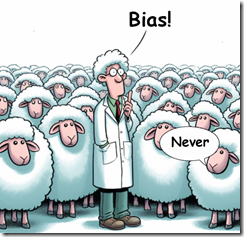LinkedIn Content Ripple: Possible Wave Amplification
April 19, 2024
 This essay is the work of a dumb dinobaby. No smart software required.
This essay is the work of a dumb dinobaby. No smart software required.
Google continues to make headlines. This morning (April 19, 2024) I flicked through the information in my assorted newsreaders. The coverage of Google’s calling the police and have alleged non-Googley professionals chatted up by law enforcement sparked many comments. One of those comments about this most recent demonstration of management mastery was from Dr. Timnit Gebru. My understanding of the Gebru incident is that she called attention to the bias in Google’s smart software systems and methods. She wrote a paper. Big thinkers at Google did not like the paper. The paper appeared, and Dr. Gebru disappeared from the Google payroll. I am have over simplified this remarkable management maneuver, but like some of Google’s synthetic data, I think I am close enough for horse shoes.
Is change coming to a social media service which has been quite homogeneous? Thanks, MSFT Copilot. How’s the security work coming?
Dr. Gebru posted a short item on LinkedIn, which is Microsoft’s professional social media service. Here’s what Dr. Gebru made available to LinkedIn’s members:
Not even 24 hrs after making history as the first company to mass fire workers for pro-Palestine protests, by summarily firing 28 people, Google announced that the “(ir)responsible AI org,” the one they created in response to firing me, is now reporting up the Israeli office, through an SVP there. Seems like they want us to know how forcefully and clearly they are backing this genocide.
To provide context, Dr. Gebru linked to a Medium (a begging for dollars information service). That article brandished the title “STATEMENT from Google Workers with the No Tech for Apartheid Campaign on Google’s Mass, Retaliatory Firings of Workers: [sic].” This Medium article is at this link. I am not sure if [a] these stories are going to require registration or payment to view and [b] the items will remain online.
What’s interesting about the Dr. Gebru item and her link is the comments made by LinkedIn members. These suggest that [a] most LinkedIn members either did not see Dr. Gebru’s post or were not motivated go click one of the “response” icons or [b] topics like Google’s management mastery are not popular with the LinkedIn audience.
Several observations based on my experience:
- Dr. Gebru’s use of LinkedIn may be a one-time shot, but on the other hand, it might provide ideas for others with a specific point of view to use as a platform
- With Apple’s willingness to remove Meta apps from the Chinese iPhone app store, will LinkedIn follow with its own filtering of content? I don’t know the answer to the question, but clicking on Dr. Gebru’s link will make it easy to track
- Will LinkedIn begin to experience greater pressure to allow content not related to self promotion and look for business contacts? I have noticed an uptick in requests from what appear to be machine-generated images preponderately young females asking, “Will you be my contact?” I routinely click, No, and I often add a comment along the lines of “I am 80 years old. Why do you want to interact with me?”
Net net: Change may be poised to test some of the professional social media service’s policies.
Stephen E Arnold, March 19, 2024
Nah, AI Is for Little People Too. Ho Ho Ho
April 5, 2024
 This essay is the work of a dumb dinobaby. No smart software required.
This essay is the work of a dumb dinobaby. No smart software required.
I like the idea that smart software is open. Anyone can download software and fire up that old laptop. Magic just happens. The reality is that smart software is going to involve some big outfits and big bucks when serious applications or use cases are deployed. How do I know this? Well, I read “Microsoft and OpenAI Reportedly Building $100 Billion Secret Supercomputer to Train Advanced AI.” The number $100 billion in not $6 trillion bandied about by Sam AI-Man a few weeks ago. It does, however, make Amazon’s paltry $3 billion look like chump change. And where does that leave the AI start ups, the AI open source champions, and the plain vanilla big-smile venture folks? The answer is, “Ponying up some bucks to get that AI to take flight.”
Thanks, MSFT Copilot. Stick to your policies.
The write up states:
… the dynamic duo are working on a $100 billion — that’s "billion" with a "b," meaning a sum exceeding many countries’ gross domestic products — on a hush-hush supercomputer designed to train powerful new AI.
The write up asks a question some folks with AI sparkling in their eyes cannot answer; to wit:
Needless to say, that’s a mammoth investment. As such, it shines an even brighter spotlight on a looming question for the still-nascent AI industry: how’s the whole thing going to pay for itself?
But I know the answer: With other people’s money and possibly costs distributed across many customers.
Observations are warranted:
- The cost of smart software is likely to be an issue for everyone. I don’t think “free” is the same as forever
- Mistral wants to do smaller language models, but Microsoft has “invested” in that outfit as well. If necessary, some creative end runs around an acquisition may be needed because MSFT may want to take Mistral off the AI chess board
- What’s the cost of the electricity to operate what $100 billion can purchase? How about a nifty thorium reactor?
Net net: Okay, Google, what is your move now that MSFT has again captured the headlines?
Stephen E Arnold, April 5, 2024
AI Innovation: Do Just Big Dogs Get the Fat, Farmed Salmon?
March 20, 2024
 This essay is the work of a dumb dinobaby. No smart software required.
This essay is the work of a dumb dinobaby. No smart software required.
Let’s talk about statements like “AI will be open source” and “AI has spawned hundreds, if not thousands, of companies.” Those are assertions which seem to be slightly different from what’s unfolding at some of the largest technology outfits in the world. The circling and sniffing allegedly underway between the Apple and the Google pack is interesting. Apple and Google have a relationship, probably one that will need marriage counselor, but it is a relationship.
The wizard scientists have created an interesting digital construct. Thanks, MSFT Copilot. How are you coming along with your Windows 11 updates and Azure security today? Oh, that’s too bad.
The news, however, is that Microsoft is demonstrating that it wants to eat the fattest salmon in the AI stream. Microsoft has a deal of some type with OpenAI, operating under the steady hand of Sam AI-Man. Plus the Softies have cozied up to the French outfit Mistral. Today at 530 am US Eastern I learned that Microsoft has embraced an outstanding thinker, sensitive manager, and pretty much the entire Inflection AI outfit.
The number of stories about this move reflect the interest in smart software and what may be one of world’s purveyor of software which attracts bad actors from around the world. Thinking about breaches in the new Microsoft world is not a topic in the write ups about this deal. Why? I think the management move has captured attention because it is surprising, disruptive, and big in terms of money and implications.
“Microsoft Hires DeepMind Co-Founder Suleyman to Run Consumer AI” states:
DeepMind workers complained about his [former Googler Mustafa Suleyman and subsequent Inflection.ai senior manager] management style, the Financial Times reported. Addressing the complaints at the time, Suleyman said: “I really screwed up. I was very demanding and pretty relentless.” He added that he set “pretty unreasonable expectations” that led to “a very rough environment for some people. I remain very sorry about the impact that caused people and the hurt that people felt there.” Suleyman was placed on leave in 2019 and months later moved to Google, where he led AI product management until exiting in 2022.
Okay, a sensitive manager learns from his mistakes joins Microsoft.
And Microsoft demonstrates that the AI opportunity is wide open. “Why Microsoft’s Surprise Deal with $4 Billion Startup Inflection Is the Most Important Non-Acquisition in AI” states:
Even since OpenAI launched ChatGPT in November 2022, the tech world has been experiencing a collective mania for AI chatbots, pouring billions of dollars into all manner of bots with friendly names (there’s Claude, Rufus, Poe, and Grok — there’s event a chatbot name generator). In January, OpenAI launched a GPT store that’s chock full of bots. But how much differentiation and value can these bots really provide? The general concept of chatbots and copilots is probably not going away, but the demise of Pi may signal that reality is crashing into the exuberant enthusiasm that gave birth to a countless chatbots.
Several questions will be answered in the weeks ahead:
- What will regulators in the EU and US do about the deal when its moving parts become known?
- How will the kumbaya evolve when Microsoft senior managers, its AI partners, and reassigned Microsoft employees have their first all-hands Teams or off-site meeting?
- Does Microsoft senior management have the capability of addressing the attack surface of the new technologies and the existing Microsoft software?
- What happens to the AI ecosystem which depends on open source software related to AI if Microsoft shifts into “commercial proprietary” to hit revenue targets?
- With multiple AI systems, how are Microsoft Certified Professional agents going to [a] figure out what broke and [b] how to fix it?
- With AI the apparent “next big thing,” how will adversaries like nations not pals with the US respond?
Net net: How unstable is the AI ecosystem? Let’s ask IBM Watson because its output is going to be as useful as any other in my opinion. My hunch is that the big dogs will eat the fat, farmed salmon. Who will pull that lucious fish from the big dog’s maw? Not me.
Stephen E Arnold, March 20, 2024
Microsoft Decides to Work with CISPE on Cloudy Concerns
March 19, 2024
 This essay is the work of a dumb dinobaby. No smart software required.
This essay is the work of a dumb dinobaby. No smart software required.
Perhaps a billion and a half dollars in fines can make a difference to a big tech company after all. In what looks like a move to avoid more regulatory scrutiny, Yahoo Finance reports, “Microsoft in Talks to End Trade Body’s Cloud Computing Complaint.” The trade body here is CISPE, a group of firms that provide cloud services in Europe. Amazon is one of those, but 26 smaller companies are also members. The group asserts certain changes Microsoft made to its terms of service in October of 2022 have harmed Europe’s cloud computing ecosystem. How, exactly, is unclear. Writer Foo Yun Chee tells us:
“[CISPE] said it had received several complaints about Microsoft, including in relation to its product Azure, which it was assessing based on its standard procedures, but declined to comment further. Azure is Microsoft’s cloud computing platform. CISPE said the discussions were at an early stage and it was uncertain whether these would result in effective remedies but said ‘substantive progress must be achieved in the first quarter of 2024’. ‘We are supportive of a fast and effective resolution to these harms but reiterate that it is Microsoft which must end its unfair software licensing practices to deliver this outcome,’ said CISPE secretary general Francisco Mingorance. Microsoft, which notched up 1.6 billion euros ($1.7 billion) in EU antitrust fines in the previous decade, has in recent years changed its approach towards regulators to a more accommodative one.”
Just how accommodating with Microsoft will be remains to be seen.
Cynthia Murrell, March 19, 2024
Microsoft and Security: A Rerun with the Same Worn-Out Script
March 12, 2024
 This essay is the work of a dumb dinobaby. No smart software required.
This essay is the work of a dumb dinobaby. No smart software required.
The Marvel cinematic universe has spawned two dozen sequels. Microsoft’s security circus features are moving up fast in the reprise business. Unfortunately there is no super hero who comes to the rescue of the giant American firm. The villains in these big screen stunners are a bit like those in the James Bond films. Microsoft seems to prefer to wrestle with the allegedly Russian cozy bear or at least convert a cartoon animal into the personification of evil.
Thanks, MSFT, you have nailed security theater and reruns of the same tired story.
What’s interesting about these security blockbusters is that each follows a Hollywood style “you’ve seen this before nudge nudge” approach to the entertainment. The sequence is a belated announcement that Microsoft security has been breached. The evil bad actors have stolen data, corrupted software, and by brute force foiled the norm cores in Microsoft World. Then announcements about fixes that the Microsoft custoemr must implement along with admonitions to keep that MSFT software updated and warnings about using “old” computers, etc. etc.
“Russian Hackers Accessed Microsoft Source Code” is the equivalent of New York Times film review. The write up reports:
In January, Microsoft disclosed that Russian hackers had breached the company’s systems and managed to read emails belonging to senior executives. Now, the company has revealed that the breach was worse than initially understood and that the Russian hackers accessed Microsoft source code. Friday’s revelation — made in a blog post and a filing with the Securities and Exchange Commission — is the latest in a string of breaches affecting the company that have raised major questions in Washington about Microsoft’s security posture.
Well, that’s harsh. No mention of the estimable alleged monopoly’s releasing the information on March 7, 2024. I am capturing my thoughts on March 8, 2024. But with college basketball moving toward tournament time, who cares? I am not really sure any more. And Washington? Does the name evoke a person, a committee, a committee consisting of the heads of security committees, someone in the White House, an “expert” at the suddenly famous National Bureau of Standards, or absolutely no one.
The write asserts:
The company is concerned, however, that “Midnight Blizzard is attempting to use secrets of different types it has found,” including in emails between customers and Microsoft. “As we discover them in our exfiltrated email, we have been and are reaching out to these customers to assist them in taking mitigating measures,” the company said in its blog post. The company describes the incident as an example of “what has become more broadly an unprecedented global threat landscape, especially in terms of sophisticated nation-state attacks.” In response, the company has said it is increasing the resources and attention devoted to securing its systems.
Microsoft is “reaching out.” I can reach for a donut, but I do not grasp it and gobble it down. “Reach” is not the same as fixing the problems Microsoft caused.
Several observations:
- Microsoft is an alleged monopoly, and it is allowing its digital trains to set fire to the fields, homes, and businesses which have to use its tracks. Isn’t it time for purposeful action from the US government agencies with direct responsibility for cyber security and appropriate business conduct?
- Can Microsoft remediate its problems? My answer is, “No.” Vulnerabilities are engineered in because no one has the time, energy, or interest to chase down problems and fix them. There is an ageing programmer named Steve Gibson. His approach to software is the exact opposite of Microsoft’s. Mr. Gibson will never be a trillion dollar operation, but his software works. Perhaps Microsoft should consider adopting some of Mr. Gibson’s methods.
- Customers have to take a close look at the security breaches endlessly reported by cyber security companies. Some outfits’ software is on the list most of the time. Other companies’ software is an infrequent visitor to these breach parties. Is it time for customers to be looking for an alternative to what Microsoft provides?
Net net: A new security release will be coming to the computer near you. Don’t fail to miss it.
Stephen E Arnold, March 12, 2024
x
x
x
x
x
Sales SEO: A New Tool for Hype and Questionable Relevance
February 5, 2024
 This essay is the work of a dumb dinobaby. No smart software required.
This essay is the work of a dumb dinobaby. No smart software required.
Search engine optimization is a relevance eraser. Now SEO has arrived for a human. “Microsoft Copilot Can Now Write the Sales Pitch of a Lifetime” makes clear that hiring is going to become more interesting for both human personnel directors (often called chief people officers) and AI-powered résumé screening systems. And for people who are responsible for procurement, figuring out when a marketing professional is tweaking the truth and hallucinating about a product or service will become a daily part of life… in theory.
Thanks for the carnival barker image, MSFT Copilot Bing thing. Good enough. I love the spelling of “asiractson”. With workers who may not be able to read, so what? Right?
The write up explains:
Microsoft Copilot for Sales uses specific data to bring insights and recommendations into its core apps, like Outlook, Microsoft Teams, and Word. With Copilot for Sales, users will be able to draft sales meeting briefs, summarize content, update CRM records directly from Outlook, view real-time sales insights during Teams calls, and generate content like sales pitches.
The article explains:
… Copilot for Service for Service can pull in data from multiple sources, including public websites, SharePoint, and offline locations, in order to handle customer relations situations. It has similar features, including an email summary tool and content generation.
Why is MSFT expanding these interesting functions? Revenue. Paying extra unlocks these allegedly remarkable features. Prices range from $240 per year to a reasonable $600 per year per user. This is a small price to pay for an employee unable to craft solutions that sell, by golly.
Stephen E Arnold, February 5, 2024
Microsoft Security: Are the Doors Falling Off?
January 22, 2024
 This essay is the work of a dumb dinobaby. No smart software required.
This essay is the work of a dumb dinobaby. No smart software required.
“Microsoft Network Breached Through Password-Spraying by Russian-State Hackers” begs to be set to music. I am thinking about Chubby Checker and his hit “Let’s Twist Again.” One lyric change. Twist becomes “hacked.” So “let’s hack again like we did last summer.” Hit?
A Seattle-based quality and security engineer finds that his automobile door has fallen off. Its security system is silent. It must be the weather. Thanks, MSFT second class Copilot Bing thing. Good enough but the extra wheel is an unusual and creative touch.
The write up states:
Russia-state hackers exploited a weak password to compromise Microsoft’s corporate network and accessed emails and documents that belonged to senior executives and employees working in security and legal teams, Microsoft said [on January 19, 2024]. The attack, which Microsoft attributed to a Kremlin-backed hacking group it tracks as Midnight Blizzard, is at least the second time in as many years that failures to follow basic security hygiene has resulted in a breach that has the potential to harm customers.
The Ars Technica story noted:
A Microsoft representative said the company declined to answer questions, including whether basic security practices were followed.
Who did this? One of the Axis of Evil perhaps. Why hack Microsoft? Because it is a big, juicy target? Were the methods sophisticated, using artificial intelligence to outmaneuver state-of-the-art MSFT cyber defenses? Nope. It took seven weeks to detect the password guessing tactic.
Did you ever wonder why door fall off Seattle-linked aircraft and security breaches occur at Seattle’s big software outfit? A desire for profits, laziness, indifference, or some other factor is causing these rather high-profile issues. It must be the Seattle water or the rain. That’s it. The rain! No senior manager can do anything about the rain. Perhaps a solar wind will blow and make everything better?
Stephen E Arnold, January 22, 2024
Regulators Shift into Gear to Investigate an AI Tie Up
January 19, 2024
 This essay is the work of a dumb dinobaby. No smart software required.
This essay is the work of a dumb dinobaby. No smart software required.
Solicitors, lawyers, and avocats want to mark the anniversary of the AI big bang. About one year ago, Microsoft pushed Google into hitting its Code Red button. Investment firms, developers, and wild-eyed entrepreneurs knew smart software was the real deal, not a digital file of a cartoon like that NFT baloney. In the last 12 months, AI went from jargon and eliciting yawns to the treasure map to the fabled city of El Dorado (even if it was a suburb of Grants, New Mexico. Google got the message quickly. The lawyers. Well, not too quickly.
Regulators look through the technological pile of 2023 gadgets. Despite being last year’s big thing, the law makers and justice deciders move into action mode. Exciting. Thanks, MSFT Copilot Bing thing. Good enough.
“EU Joins UK in Scrutinizing OpenAI’s Relationship with Microsoft” documents what happens when lawyers — after decades of inaction — wake to do something constructive. Social media gutted the fabric of many cultural norms. AI isn’t going to be given a 20 year free pass. No way.
The write up reports:
Antitrust regulators in the EU have joined their British counterparts in scrutinizing Microsoft’s alliance with OpenAI.
What will happen now? Here’s my short list of actions:
- Legal eagles on both sides of the Atlantic will begin grooming their feathers in order to be selected to deal with the assorted forms, filings, hearings, and advisory meetings. Some of the lawyers will call Ferrari to make sure they are eligible to buy a supercar; others may cast an eye on an impounded oligarch-linked yacht. Yep, big bucks ahead.
- Microsoft and OpenAI will let loose an platoon of humanoid art history and business administration majors. These professionals will create a wide range of informative explainers. Smart software will be pressed into duty, and I anticipate some smart automation to provide Teflon the the flow of digital documentation.
- Firms — possibly some based in the EU and a few bold souls in the US — will present information making clear that competition is a good thing. Governments must regulate smart software
- Entities hostile to the EU and the US will also output information or disinformation. Which is what depends on one’s perspective.
In short, 2024 will be an interesting year because one of the major threat to the Google could be converted to the digital equivalent of a eunuch in an Assyrian ruler’s court. What will this mean? Google wins. Unanticipated consequence? Absolutely.
Stephen E Arnold, January 19, 2024
A Swiss Email Provider Delivers Some Sharp Cheese about MSFT Outlook
January 17, 2024
 This essay is the work of a dumb dinobaby. No smart software required.
This essay is the work of a dumb dinobaby. No smart software required.
What company does my team love more than Google? Give up. It is Microsoft. Whether it is the invasive Outlook plug in for Zoom on the Mac or the incredible fly ins, pop ups, and whining about Edge, what’s not to like about this outstanding, customer-centric firm? Nothing. That’s right. Nothing Microsoft does can be considered duplicitous, monopolistic, avaricious, or improper. The company lives and breathes the ethics of Thomas Dewey, the 19 century American philosopher. This is my opinion, of course. Some may disagree.
A perky Swiss farmer delivers an Outlook info dump. Will this delivery enable the growth of suveillance methodologies? Thanks, MSFT Copilot Bing thing. Thou did not protest when I asked for this picture.
I read and was troubled that one of my favorite US firms received some critical analysis about the MSFT Outlook email program. The sharp comments appeared in a blog post titled “Outlook Is Microsoft’s New Data Collection Service.” Proton offers an encrypted email service and a VPN from Switzerland. (Did you know the Swiss have farmers who wash their cows and stack their firewood neatly? I am from central Illinois, and our farmers ignore their cows and pile firewood. As long as a cow can make it into the slaughter house, the cow is good to go. As long as the firewood burns, winner.)
The write up reports or asserts, depending on one’s point of view:
Everyone talks about the privacy-washing(new window) campaigns of Google and Apple as they mine your online data to generate advertising revenue. But now it looks like Outlook is no longer simply an email service(new window); it’s a data collection mechanism for Microsoft’s 772 external partners and an ad delivery system for Microsoft itself.
Surveillance is the key to making money from advertising or bulk data sales to commercial and possibly some other organizations. Proton enumerates how these sucked up data may be used:
- Store and/or access information on the user’s device
- Develop and improve products
- Personalize ads and content
- Measure ads and content
- Derive audience insights
- Obtain precise geolocation data
- Identify users through device scanning
The write up provides this list of information allegedly available to Microsoft:
- Name and contact data
- Passwords
- Demographic data
- Payment data
- Subscription and licensing data
- Search queries
- Device and usage data
- Error reports and performance data
- Voice data
- Text, inking, and typing data
- Images
- Location data
- Content
- Feedback and ratings
- Traffic data.
My goodness.
I particularly like the geolocation data. With Google trying to turn off the geofence functions, Microsoft definitely may be an option for some customers to test. Good, bad, or indifferent, millions of people use Microsoft Outlook. Imagine the contact lists, the entity names, and the other information extractable from messages, attachments, draft folders, and the deleted content. As an Illinois farmer might say, “Winner!”
For more information about Microsoft’s alleged data practices, please, refer to the Proton article. I became uncomfortable when I read the section about how MSFT steals my email password. Imagine. Theft of a password — Is it true? My favorite giant American software company would not do that to me, a loyal customer, would it?
The write up is a bit of content marketing rah rah for Proton. I am not convinced, but I think I will have my team do some poking around on the Proton Web site. But Microsoft? No, the company would not take this action would it?
Stephen E Arnold, January 17, 2023
An Effort to Put Spilled Milk Back in the Bottle
December 15, 2023
 This essay is the work of a dumb dinobaby. No smart software required.
This essay is the work of a dumb dinobaby. No smart software required.
Microsoft was busy when the Activision Blizzard saga began. I dimly recall thinking, “Hey, one way to distract people from the SolarWinds’ misstep would be to become an alleged game monopoly.” I thought that Microsoft would drop the idea, but, no. I was wrong. Microsoft really wanted to be an alleged game monopoly. Apparently the successes (past and present) of Nintendo and Sony, the failure of Google’s Grand Slam attempt, and the annoyance of refurbished arcade game machines was real. Microsoft has focus. And guess what government agency does not? Maybe the Federal Trade Commission?
Two bureaucrats to be engage in a mature discussioin about the rules for the old-fashioned game of Monopoly. One will become a government executive; the other will become a senior legal professional at a giant high-technology outfit. Thanks, MSFT Copilot. You capture the spirit of rational discourse in a good enough way.
The MSFT game play may not be over. “The FTC Is Trying to Get Back in the Ring with Microsoft Over Activision Deal” asserts:
Nearly five months later, the FTC has appealed the court’s decision, arguing that the lower court essentially just believed whatever Microsoft said at face value…. We said at the time that Microsoft was clearly taking the complaints from various regulatory bodies as some sort of paint by numbers prescription as to what deals to make to get around them. And I very much can see the FTC’s point on this. It brought a complaint under one set of facts only to have Microsoft alter those facts, leading to the courts slamming the deal through before the FTC had a chance to amend its arguments. But ultimately it won’t matter. This last gasp attempt will almost certainly fail. American regulatory bodies have dull teeth to begin with and I’ve seen nothing that would lead me to believe that the courts are going to allow the agency to unwind a closed deal after everything it took to get here.
From my small office in rural Kentucky, the government’s desire or attempt to get “back in the ring” is interesting. It illustrates how many organizations approach difficult issues.
The advantage goes to the outfit with [a] the most money, [b] the mental wherewithal to maintain some semblance of focus, and [c] a mechanism to keep moving forward. The big four wheel drive will make it through the snow better than a person trying to ride a bicycle in a blizzard.
The key sentence in the cited article, in my opinion, is:
“I fail to understand how giving somebody a monopoly of something would be pro-competitive,” said Imad Dean Abyad, an FTC attorney, in the argument Wednesday before the appeals court. “It may be a benefit to some class of consumers, but that is very different than saying it is pro-competitive.”
No problem with that logic.
And who is in charge of today Monopoly games?
Stephen E Arnold, December 15, 2023











